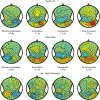Role of Alpha-Band Oscillations in Spatial Updating across Whole Body Motion
- PMID: 27199882
- PMCID: PMC4858599
- DOI: 10.3389/fpsyg.2016.00671
Role of Alpha-Band Oscillations in Spatial Updating across Whole Body Motion
Abstract
When moving around in the world, we have to keep track of important locations in our surroundings. In this process, called spatial updating, we must estimate our body motion and correct representations of memorized spatial locations in accordance with this motion. While the behavioral characteristics of spatial updating across whole body motion have been studied in detail, its neural implementation lacks detailed study. Here we use electroencephalography (EEG) to distinguish various spectral components of this process. Subjects gazed at a central body-fixed point in otherwise complete darkness, while a target was briefly flashed, either left or right from this point. Subjects had to remember the location of this target as either moving along with the body or remaining fixed in the world while being translated sideways on a passive motion platform. After the motion, subjects had to indicate the remembered target location in the instructed reference frame using a mouse response. While the body motion, as detected by the vestibular system, should not affect the representation of body-fixed targets, it should interact with the representation of a world-centered target to update its location relative to the body. We show that the initial presentation of the visual target induced a reduction of alpha band power in contralateral parieto-occipital areas, which evolved to a sustained increase during the subsequent memory period. Motion of the body led to a reduction of alpha band power in central parietal areas extending to lateral parieto-temporal areas, irrespective of whether the targets had to be memorized relative to world or body. When updating a world-fixed target, its internal representation shifts hemispheres, only when subjects' behavioral responses suggested an update across the body midline. Our results suggest that parietal cortex is involved in both self-motion estimation and the selective application of this motion information to maintaining target locations as fixed in the world or fixed to the body.
Keywords: electroencephalography; oscillations; parietal cortex; self-motion; vestibular; visual stability.
Figures







Similar articles
-
Parallax-sensitive remapping of visual space in occipito-parietal alpha-band activity during whole-body motion.J Neurophysiol. 2015 Mar 1;113(5):1574-84. doi: 10.1152/jn.00477.2014. Epub 2014 Dec 10. J Neurophysiol. 2015. PMID: 25505108 Free PMC article.
-
Causal inference for spatial constancy across whole body motion.J Neurophysiol. 2019 Jan 1;121(1):269-284. doi: 10.1152/jn.00473.2018. Epub 2018 Nov 21. J Neurophysiol. 2019. PMID: 30461369
-
Alpha-band transcranial alternating current stimulation modulates precision, but not gain during whole-body spatial updating.Neuropsychologia. 2017 Nov;106:52-59. doi: 10.1016/j.neuropsychologia.2017.09.005. Epub 2017 Sep 6. Neuropsychologia. 2017. PMID: 28888892
-
Parietal and hippocampal contribution to topokinetic and topographic memory.Philos Trans R Soc Lond B Biol Sci. 1997 Oct 29;352(1360):1437-48. doi: 10.1098/rstb.1997.0130. Philos Trans R Soc Lond B Biol Sci. 1997. PMID: 9368932 Free PMC article. Review.
-
Vestibular contributions to high-level sensorimotor functions.Neuropsychologia. 2017 Oct;105:144-152. doi: 10.1016/j.neuropsychologia.2017.02.004. Epub 2017 Feb 2. Neuropsychologia. 2017. PMID: 28163007 Review.
Cited by
-
The role of delta and theta oscillations during ego-motion in healthy adult volunteers.Exp Brain Res. 2021 Apr;239(4):1073-1083. doi: 10.1007/s00221-020-06030-3. Epub 2021 Feb 3. Exp Brain Res. 2021. PMID: 33534022 Free PMC article.
-
Electroencephalographic response to transient adaptation of vestibular perception.J Physiol. 2022 Aug;600(15):3517-3535. doi: 10.1113/JP282470. Epub 2022 Jul 7. J Physiol. 2022. PMID: 35713975 Free PMC article.
-
Dynamic Office Environments Improve Brain Activity and Attentional Performance Mediated by Increased Motor Activity.Front Hum Neurosci. 2019 Apr 12;13:121. doi: 10.3389/fnhum.2019.00121. eCollection 2019. Front Hum Neurosci. 2019. PMID: 31031610 Free PMC article.
-
On the Dynamics of Spatial Updating.Front Neurosci. 2022 Feb 17;16:780027. doi: 10.3389/fnins.2022.780027. eCollection 2022. Front Neurosci. 2022. PMID: 35250442 Free PMC article.
-
Two Neural Circuits to Point Towards Home Position After Passive Body Displacements.Front Neural Circuits. 2019 Oct 30;13:70. doi: 10.3389/fncir.2019.00070. eCollection 2019. Front Neural Circuits. 2019. PMID: 31736717 Free PMC article.
References
-
- Ahmad H., Arshad Q., Siddiqui S., Nigmatullina Y., Patel M., Bronstein A. M., et al. (2014). Applications of neuromodulation to explore vestibular cortical processing; new insights into the effects of direct current cortical modulation upon pursuit, VOR and VOR suppression. J. Vestib. Res. 24 453–458. 10.3233/VES-140530 - DOI - PubMed
LinkOut - more resources
Full Text Sources
Other Literature Sources

